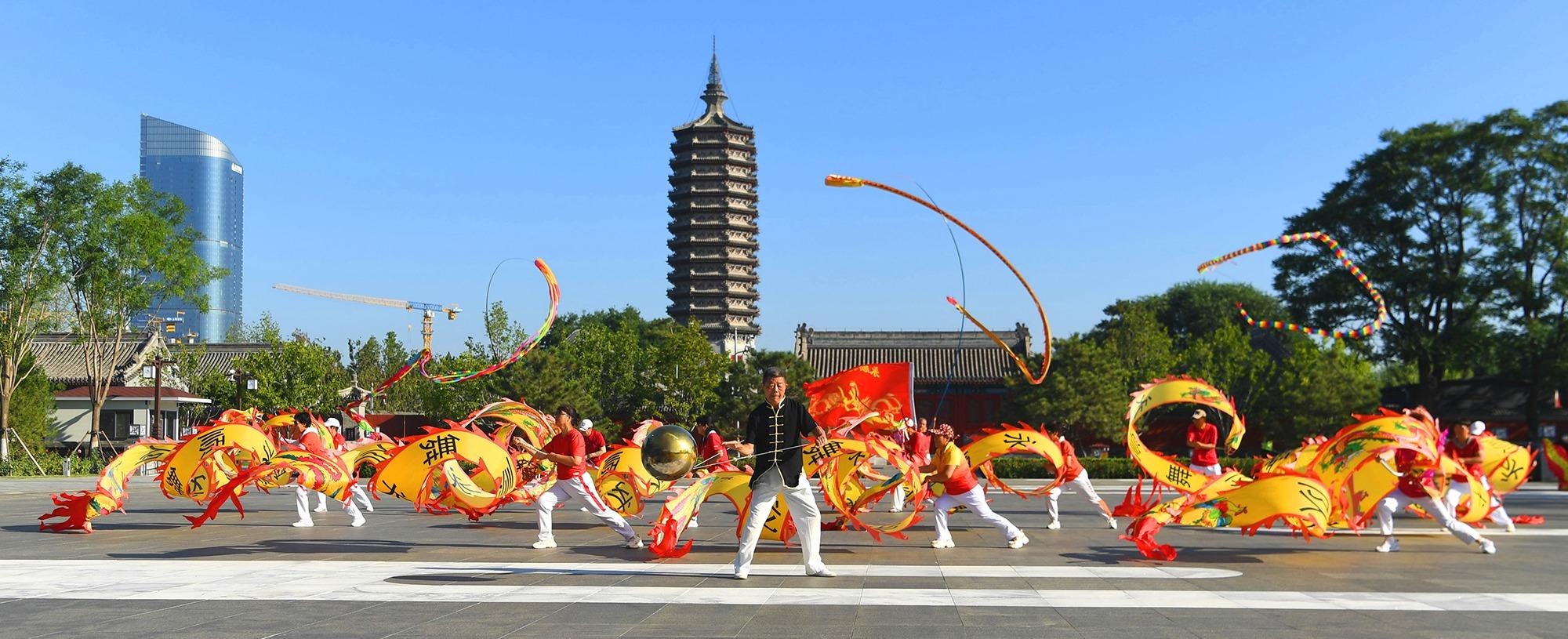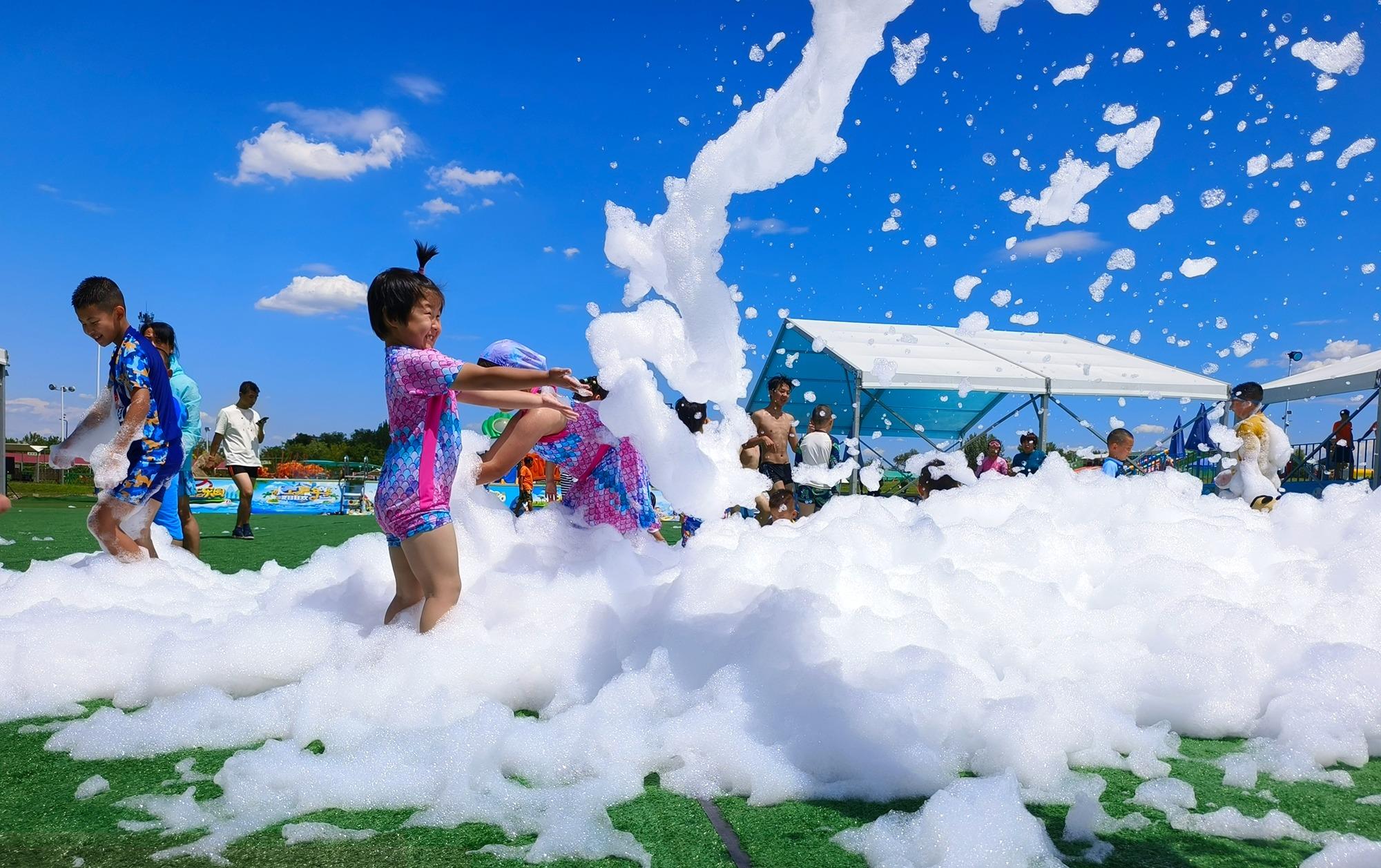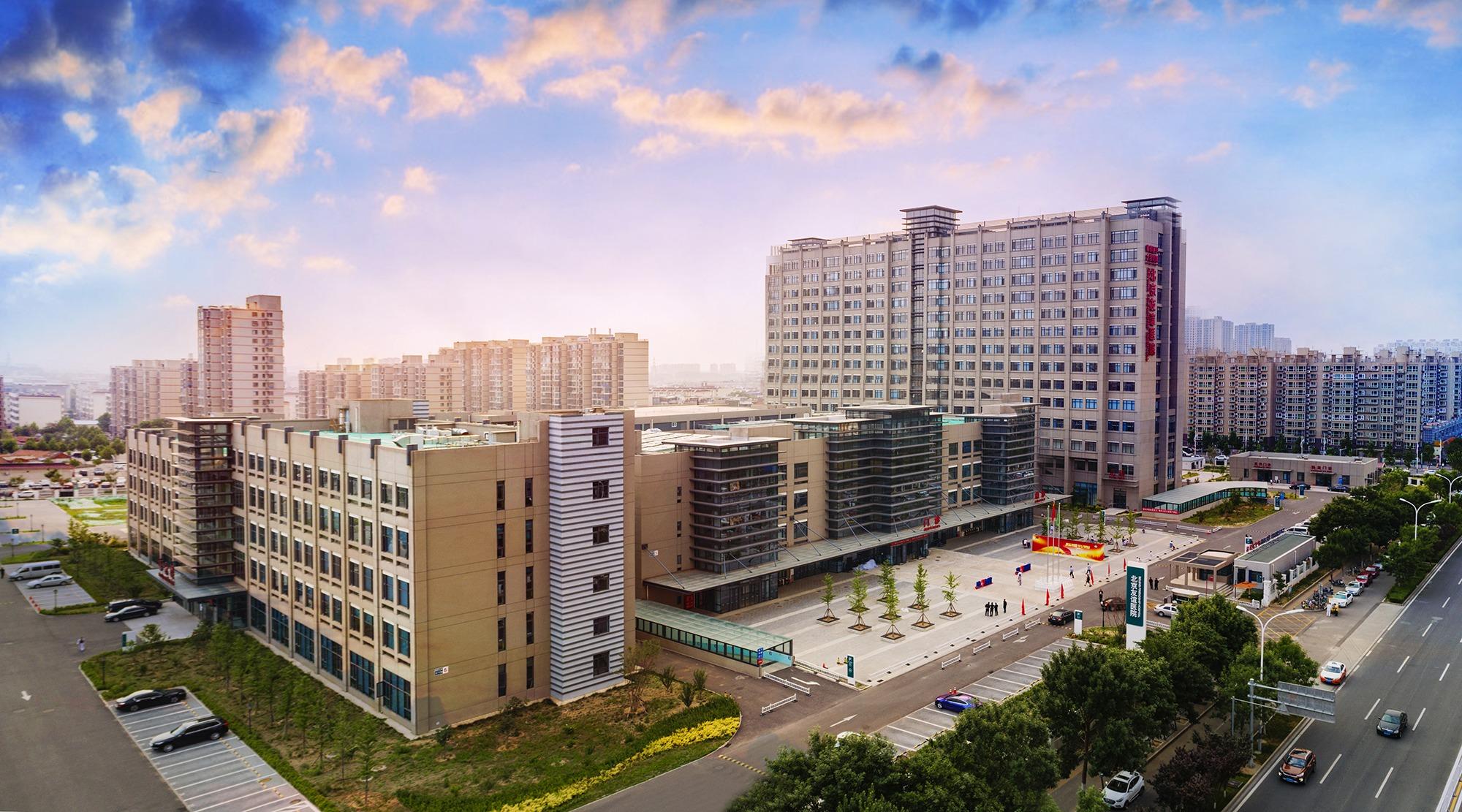New area showcases green, high-quality development model
 The Beijing sub city-center provides residents with different choices of recreation, including ice and snow activities, Spring Festival celebrations and dragon dance performances. (PROVIDED TO CHINA DAILY)
The Beijing sub city-center provides residents with different choices of recreation, including ice and snow activities, Spring Festival celebrations and dragon dance performances. (PROVIDED TO CHINA DAILY)
Situated more than 20 kilometers east of Tian'anmen Square, Beijing's burgeoning sub city-center stands as a beacon of progress and promise, poised to usher in a new era of dynamic growth only 10 years after it was first floated.
The coordinated development strategy for Beijing, Tianjin and Hebei province was proposed by President Xi Jinping at a meeting on Feb 26, 2014, after his inspection tour of the capital.
In May 2016, the central government began implementing plans to establish the Beijing sub city-center, with the first phase involving laying the foundations and addressing challenges that would arise during the development stages.
The first and second phases of the city's municipal administrative office area have been completed, and more than 30,000 staff members have moved to live and work in the center, a significant factor in ensuring its viability.
READ MORE: Beijing-Tianjin-Hebei coordination nets results
A total of 61 Beijing municipal State-owned enterprises and their subsidiaries have relocated to the sub city-center.
Meanwhile, new cultural, recreational and entertainment facilities have added to the area's appeal. Universal Studios Beijing has based itself there, along with the Beijing Performing Arts Center, Beijing Library and the Grand Canal Museum of Beijing, which opened in late December, all enriching residents' daily lives.
The sub city-center is also attracting an increasing number of visitors from other areas of Beijing who like to enjoy cultural and entertainment activities, such as spending weekends strolling around Central Green Forest Park or exploring the Grand Canal Museum's exhibitions.
Hu Jiulong, the deputy director of the sub city-center management committee, has an affinity for the area and wants to move there from his current home in downtown Beijing.
"My greatest wish is to move here as soon as possible," he told China Daily. "The place has been updated in all aspects. I especially appreciate the environment here, and as a sports enthusiast I hope to make this my home," he said, adding he commutes using suburban trains and the subway system.
 Visitors have been allowed to take a free trial ride on driverless buses since March 3, 2024. (HUANG LIANG / FOR CHINA DAILY)
Visitors have been allowed to take a free trial ride on driverless buses since March 3, 2024. (HUANG LIANG / FOR CHINA DAILY)
Green transformation
As a member of the sub city-center's management team, Hu has witnessed firsthand the rapid development of the area in recent years.
At the heart of the 155-square-kilometer core area of the center lies the Central Green Forest Park, which is planned to eventually cover a total area of 11.2 sq km.
"The changes in the ecological environment are particularly noticeable," Hu said. "The site of the Central Green Forest Park was previously a chemical plant and three surrounding villages. In the past, there was also some soil contamination."
Environmentally sensitive methods were used during the rehabilitation and enhancement of the site, Hu said.
"Trees and plants in the former villages were relocated for the construction of the park," he said. "All the planting was designed based on keeping existing trees, rather than removing them all and planting new ones."
After the completion of work on the park, the authority invited the former villagers to inspect it. "They could recognize the trees which had been in front of their former homes," Hu said. "The development of the city is a good thing and we also want to keep their memories alive."
In March, the park was recognized at the national level as one of the first 23 cases in China of an energy-efficient, green, and low-carbon transformation project, the National Energy Administration said.
The park not only features photovoltaic panels, geothermal heat pumps, power storage and green energy, but also green buildings, charging piles, ecological restoration work and smart management systems. These diverse low-carbon applications are good examples that can be easily adopted across the country, the administration said.
By 2025, the park's energy terminals are expected to be entirely powered by green energy, achieving the goal of zero carbon emissions, according to the Beijing Investment Group, the operator of the park.
"It is different from traditional parks in the country, it is one without walls," Hu explained. "We hope to integrate the city and the forest park, providing residents with a better experience. During the road planning phase, we carefully designed the routes … to avoid conflicts between motor vehicles and pedestrians.
"Since its opening in September 2020, visitors have highly praised the park, and I often visit it myself," he said.
 The ice and snow carnival at the Central Green Forest Park, which opened in December, proved popular with visitors. (PROVIDED TO CHINA DAILY)
The ice and snow carnival at the Central Green Forest Park, which opened in December, proved popular with visitors. (PROVIDED TO CHINA DAILY)
Thriving new area
Liu Xin, 44, is one of the tens of thousands of government workers who have relocated to the sub city-center. He used to live and work in Beijing's Dongcheng district but moved when his workplace was relocated.
"The government provides dormitories for us, so I can get home in a few minutes. I can have meals in the work canteen, and there are more and more restaurants nearby, providing more choices.
"New hospitals and schools have also been built here, ensuring the education of children and the medical needs of more people," he added.
Liu said his life in the sub city-center is more convenient and easier than in Dongcheng as the population density is lower and many of the public facilities are new.
"The ecology and transportation are both good here," he said.
"If there is anything lacking, it's that many of my friends still live in the downtown area of the city, so it's not as convenient to meet them. However, recently the arts center and new library have attracted many of my friends to come here on weekends so we can hang out again."
To reassure people working in the sub city-center that the facilities are adequate, the government has built new schools and encouraged a number of high-quality schools to establish branches in the area, said Hu from the management committee.
A total of 17 respected primary and high schools have been opened in the sub city-center, providing thousands of children with high-quality education, he said.
The schools not only accept the children of relocated civil servants, but also the children of new residents and professionals who have moved to the area.
Beijing Anzhen Hospital's Tongzhou campus, with an area of 340,000 sq m, is the largest hospital under construction in the city, and is scheduled to start offering medical services in September.
The hospital will be able to deal with 6,500 outpatient and emergency visits a day, with 1,300 beds available. It will perform multiple functions such as providing outpatient services, emergency treatment, medical technology research, inpatient care, professional teaching, and rehabilitation.
The Tongzhou campus of the Beijing Friendship Hospital has already been completed and opened, Hu added. "The efficiency of seeing a doctor has improved, and the treatment experience is much better. Recently, two of my colleagues gave birth to their babies at this hospital and gave good feedback on the services," he said.
The Children's Hospital affiliated to the Capital Institute of Pediatrics will start construction of its Tongzhou campus in the second half of this year, further increasing available medical services.
"In fact, many patients who come to hospitals in the sub city-center are residents from the neighboring three counties in Hebei province," Hu said.
"The development of the sub city-center has also benefited the residents in Hebei and even Tianjin municipality. Many regular visitors to Universal Studios Beijing also come from the surrounding areas of Tianjin and Hebei," Hu said.
"We hope that the growth of the Beijing sub city-center will bring more employment, culture, ecology and convenience to these surrounding areas."
 A view of the Tongzhou campus of the Beijing Friendship Hospital. (PROVIDED TO CHINA DAILY)
A view of the Tongzhou campus of the Beijing Friendship Hospital. (PROVIDED TO CHINA DAILY)
Integrated development
The planning and construction of the Beijing sub city-center along with the formation of the Xiong'an New Area in Hebei, was a significant decision made by the central government.
At the end of February, the State Council Information Office held a news conference to outline the progress made over the past decade on the coordinated development of the Beijing-Tianjin-Hebei region.
"Breakthrough progress has been made in the relocation of noncapital functions from Beijing," Guo Lanfeng, a senior official of the National Development and Reform Commission, said at the news conference. "Focusing on addressing the 'big city malaise' of Beijing, a plan for relocation has been constructed."
The first batch of universities, hospitals, and central State-owned enterprises chosen for relocation have already begun settling in the Xiong'an New Area. Policies covering incentives, investment and household registration have also been implemented.
"The capital's functions have been continuously optimized, making Beijing the first major city in the country to realize sustainable development through reduced resources," Guo said. "At the same time, the Xiong'an New Area has entered a stage of large-scale construction and is undertaking the relocation of noncapital functions from Beijing," he said.
ALSO READ: Xiong'an eyes hub of innovation, startups
Meticulous planning is made for the use of "every inch of land" before construction begins, Guo added.
"Currently, the urban framework is taking shape, the main backbone of the road network has been completed, and the new area has its own administrative division codes and vehicle license plates," he said.
The level of coordinated development in key sectors has continued to improve, Guo said.
Transportation, ecology and industry are the major areas where breakthroughs have been made. Improvement of the integrated transportation network of the Beijing-Tianjin-Hebei region has been accelerated, and people can now travel between the major cities in 1 to 1.5 hours via high-speed trains and expressways.
"In the past decade, the growth of the Beijing-Tianjin-Hebei region mainly focused on adjusting and optimizing economic and spatial structures," he said.
In the future, the region's growth will continue to be comprehensive and high-quality, Guo said, adding that the Beijing-Tianjin-Hebei region is set to lead "the high-quality development of the entire country".


